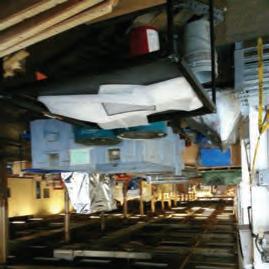
6 minute read
OSHA Issues New Directive
OSHA Issues New Directive on Respirable Crystalline Silica C rystalline silica is a common mineral found in the earth's crust. Materials like sand, stone, concrete, and mortar contain crystalline silica. It is also used to make products such as glass, pottery, ceramics, bricks, and artificial stone. Simply being near sand or other silica-containing materials is not hazardous. The hazard is created when specific activities generate respirable dust that is released into the air. R espirable crystalline silica are very small particles at least 100 times smaller than ordinary sand you might find on beaches and playgrounds and is created when cutting, sawing, grinding, drilling, and crushing stone, rock, concrete, brick, block, and mortar. Activities such as abrasive blasting with sand; sawing brick or concrete; sanding or drilling into concrete walls; grinding mortar; manufacturing brick, concrete blocks, stone countertops, or ceramic products; and cutting or crushing stone result in worker exposures to respirable crystalline silica dust. Industrial sand used in certain operations, such as foundry work and hydraulic fracturing (fracking), is also a source of respirable crystalline silica exposure. About 2.3 million people in the U.S. are exposed to silica at work. Reducing and ultimately eliminating the workplace incidence of silicosis has been a primary goal of OSHA since its inception. Br eathing in very small ("respirable") crystalline silica particles, causes multiple diseases, including silicosis, an incurable lung disease that leads to disability and death. Respirable crystalline silica also causes silicosis, lung cancer, chronic obstructive pulmonary disease (COPD), and kidney disease. Exposure to respirable crystalline silica is related to the development of autoimmune disorders and cardiovascular impairment. These occupational diseases are life-altering and debilitating disorders that annually affect thousands of workers across the United States. Silicosis Breathing crystalline silica dust can cause silicosis, which in severe cases can be disabling, or even fatal. When silica dust enters the lungs, it causes the formation of scar tissue, which makes it difficult for the lungs to take in oxygen. There is no cure for silicosis.
Silicosis typically occurs after 15–20 years of occupational exposure to respirable crystalline silica. Symptoms may or may not be obvious; therefore, workers need to have a chest x-ray to determine if there is lung damage. As the disease progresses, the worker may
continued on page 56
BRINGING ROCHESTER CITY SCHOOLS INTO THE 21 ST CENTURY






Rochester Schools Modernization Program
585.512.3820 www.rsmpnews.net @rsmpschools
2352BSGHiltonLacrosseProgramBookAd_Layout 1 9/24/2019 10:51 AM Page 1 experience shortness of breath upon exercising. In the later stages, the worker may experience fatigue, extreme shortness of breath, chest pain, or respiratory failure.
Because silicosis affects the immune system, exposure to silica increases the risk of lung infections, such as tuberculosis. In addition, smoking causes lung damage and adds to the damage caused by breathing silica dust. In rare instances, individuals exposed to very high concentrations of respirable crystalline silica can develop typical silicosis symptoms as well as fever and weight loss within weeks instead of years. In these cases, medical evaluation should be performed as soon as possible. Lung Cancer Exposur e to respirable crystalline silica increases the risk of developing lung cancer. Lung cancer is a disease where abnormal cells grow uncontrollably into tumors, interfering with lung function. The abnormal cancer cells can also travel ("metastasize") and cause damage to other parts of the body. Most cases are not curable. Chronic Obstructive Pulmonary Disease (COPD) Exposure to respirable crystalline silica increases the risk of other lung diseases, primarily COPD, which includes emphysema and chronic bronchitis. The main symptom of COPD is shortness of breath due to difficulty breathing air into the lungs. COPD is not usually reversible and may worsen over time. Kidney Disease
Studies of work ers exposed to respirable crystalline silica have found that these workers are at increased risk of developing kidney disease. For instance, kidney failure has been observed among workers with high silica exposure, such as in abrasive blasters who also were suffering from silicosis To protect workers exposed to respirable crystalline silica, OSHA has issued two respirable crystalline silica standards: one for construction, and the other for general industry and maritime.
Construction OSHA's Respirable Crystalline Silica standard for construction requires employers to limit worker exposures to respirable crystalline silica and to take other steps to protect workers. The standard provides flexible alternatives, which OSHA expects will be especially useful for small employers. Employers can either use the control methods laid out in Table 1 of the construction standard, or they can measure workers' exposure to silica and independently continued on page 58




465 BLOSSOM RD, ROCHESTER, NY 14610 585.654.8710 (ph) 585.654.8713 (fax) WWW.BSGBUILDINGSERVICES.COM




decide which dust controls work best to limit exposures to the PEL in their workplaces. Regardless of which exposure control method is used, all construction employers covered by the standard are required to: Establish and implement a written exposure control plan that identifies tasks that involve exposure and methods used to protect workers, including procedures to restrict access to work areas where high exposures may occur. Designate a competent person to implement the written exposure control plan. Restrict housekeeping practices that expose workers to silica where feasible alternatives are available. Offer medical exams-including chest X-rays and lung function tests-every three years for workers who are required by the standard to wear a respirator for 30 or more days per year. Train workers on work operations that result in silica exposure and ways to limit exposure. Keep records of exposure measurements, objective data, and medical exams.
Construction employers have been required to comply with all requirements of the standard since September 23, 2017. OSHA has recently issued a new Directive on enforcement of the standard for RCS and are in a period of outreach, training and education on these standards. OSHA will resume enforcement under this Directive beginning May 4th, 2020. OSHA provides various informational and compliance assistance guides and resources. Visit OSHA's silica rule webpage at www.osha.gov/ silica for a direct link to the standards, factsheets, answers to frequently asked questions, and to sign up for email updates on compliance dates and resources.
Compliance Guides for each industry exist as well as several educational guides, slide presentations as well as a Q&A Section. See OSHA publication 3902-07R, 2017 Small Entity Compliance Guide for Respirable Crystalline Silica Standard for Construction. OSHA provides help for employers, including technical assistance about effective safety and health programs, training and education at www.osha.gov/employers. Resources specifically for small businesses, including information about OSHA’s free On-site Consultation program, can be found at www.osha.gov/smallbusiness.
Sheet Metal Workers’ Local Union # 46 244 Paul Road Rochester NY 14624 (585) 254-9151 www.smw46.com


Fabricators and Installers of Metal & Air Systems: HVAC Systems Architectural Metal Work • HVAC Service & Controls Testing & Balancing • Residential, Commercial, Institutional & Industrial
“Quality Craftsmanship through training and high safety standards.” Servicing the Upstate New York Counties of: Livingston, Monroe, Ontario, Seneca, Wayne and Yates.
Troy R. Milne – Business Manager Anthony Valenti – Business Agent Josh Solt – President Jonathan R. Perna -- Marketing Representative
when you read this

ROBEX










